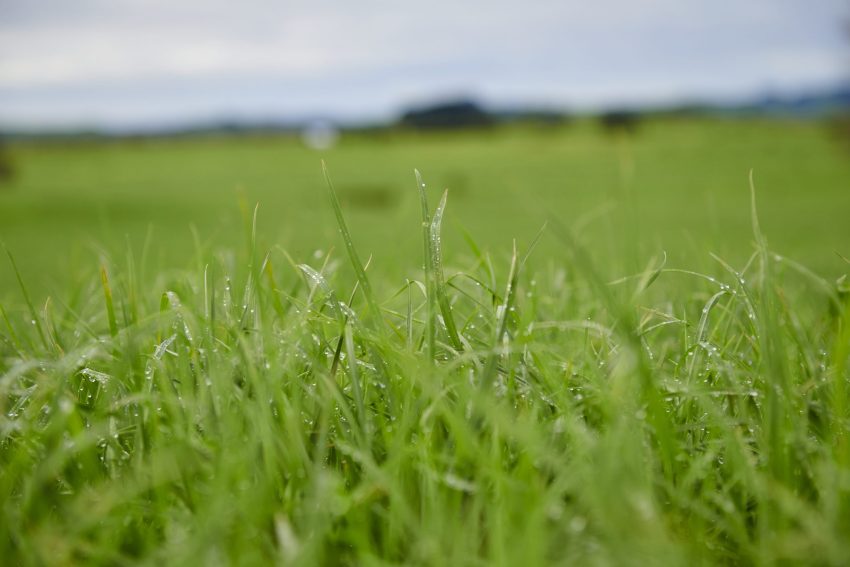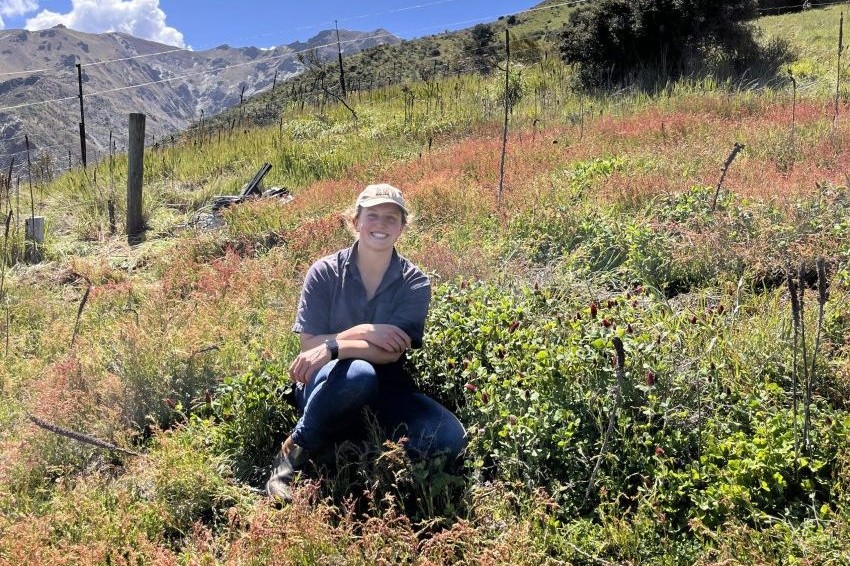BY: GREG SHEPPARD
At the time of writing, the entire North Island and the east coast of the South Island from the Selwyn district to Marlborough and Tasman are deemed to be in a state of drought.
Although we have received some welcome rain in places, pasture covers are low and soil temperature is falling as we get closer to the start of winter. Exacerbating this are the issues caused by Covid-19 lockdown restrictions – namely the inability to get surplus stock processed quickly by meat companies.
The availability of balage and hay seems to have almost dried up. Many farmers are having to consider buying alternatives and for many, unfamiliar supplements such as sheep nuts, maize and palm kernel to name but a few. But what are the financial implications of this?
I have developed a model farm which could be anywhere in the drought zone. Suffice to say that it is a very traditional system (purposely simple), the key assumptions are:
Effective area:
• 610 hectares (ha) of which 10ha is in a forage crop
• Pasture cover June 1 of 1150kg DM/ha
Livestock:
• Ewes 2500 (lambing August 15 – 130%)
• Ewe hogget’s 750 (empty and gaining 50g/day)
• Cows 115 (calving September 1, 90%)
• R2 yr Heifers (in calf) 35 (calving September 1, 90%)
• R1 yr Heifers 68 (gaining an average of 0.5 kg liveweight/day)
• R1 yr Steers 68 (gaining an average of 0.57 kg LW/day)
The effective stocking rate is 7.4su/ha and the feed profile used in this analysis is for the period from June 1 to September 30 (Table one).
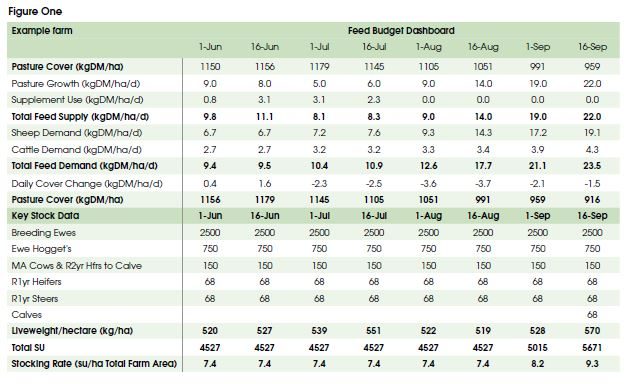 The feed demands used in the feed budget reflect the ideal situation where stock are assumed to be able to consume sufficient feed to prevent weight loss and realise their performance.
The feed demands used in the feed budget reflect the ideal situation where stock are assumed to be able to consume sufficient feed to prevent weight loss and realise their performance.
Each farm is different with its own set of pasture cover drivers such as aspect, topography, soil fertility, climate, grazing management, livestock numbers, classes and performance levels. All of which influence pasture cover – your feed budget may be quite different to this scenario.
This feed budget (Figure One) and graph (Figure Two) shows the pasture cover remaining stable through until mid-July. This is common in practice and often offers a feeling of “we’ll get through this okay”. Unfortunately, this in not reality. Feed covers will drop as the extra demand from pregnancy and early lactation kick in. In this scenario it falls to about 900kg drymatter (DM)/ha – 300kg DM/ha below target.
The target cover in this graph would allow livestock to be fully fed without remedial actions needing to be taken.
Research indicates, ewes can only be fully fed at pasture cover above 1200kg DM/ha. Having this set as the bottom out pasture cover target is critical if you wish to realise optimum performance from an enterprise such as outlined in this scenario.
As a rule of thumb, look to match this bottom out cover to the period when we can expect pasture growth to break even with pasture demand. By achieving this you optimise feeding levels and spring pasture quality. You’ll be in the driving seat.
The projected feed profile shows pasture covers dropping below adequate.
If nothing is done, there is likely to be a high incidence of metabolic problems and possible animal welfare issues over lambing and calving. Plus animals grazing down to these low covers in September are likely to have their future performance compromised.
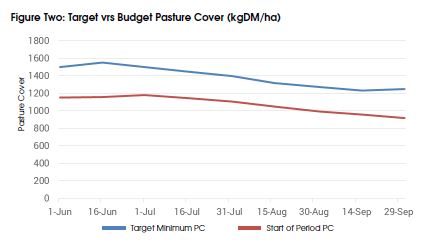 WHAT ARE THE OPTIONS?
WHAT ARE THE OPTIONS?
We find ourselves looking at the prospect of covers being 300kg DM/ha below target. This equates to a total feed shortfall of approximately 188 tonnes DM.
Fortunately, there are options within your control. Some are more palatable than others. These include:
• Graze stock off-farm
• Buy extra supplements
• Sell stock
• Apply nitrogen – too late to apply now and may not give you the lift in cover early enough in the spring
• Use ProGib – best results occur when applied in conjunction with nitrogen and when pasture is actively growing
• Accept a compromise between cost and livestock performance
Figure Three highlights the volume of feed (DM), required to fill the feed gap and the cost of doing so based on some autumn supplement prices. These costs do not include cartage and will vary between regions.
Points to consider:
• Will it be possible to source 630 bales of balage or 725 bales of hay?
• What are the practical implications of feeding out on your farm?
• How much time will be involved?
• What’s your access like?
• Is it safe to cart feed to the stock?
Not all feed is equal:
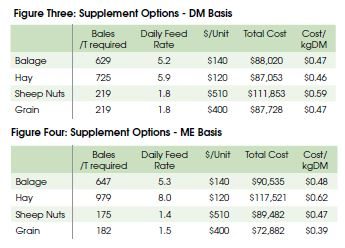 • Hay has low Metabolisable Energy (ME) and only moderate crude protein levels
• Hay has low Metabolisable Energy (ME) and only moderate crude protein levels
• Balage has moderate to good ME (depends on quality of pasture harvested) and good crude protein levels sufficient for Lwt gain and pregnancy needs. Be aware that some moulds which grow in balage can cause abortion – fresh is best!
• Sheep Nuts are grain-based, high in ME and normally formulated to contain additional protein and mineral to support liveweight gain and pregnancy needs
• Grains (wheat and barley) are high in ME but low in protein and if overfed can cause acidosis.
Figure Four considers the amount of feed required based on the ME content of the feeds. Not all feeds are equal.
Figure Four: Cost/kg DM for supplements based on Metabolisable Energy content By considering the ME content, we note that the relative cost of drymatter changes.
Hay becomes the most-costly feed at $0.62/kg DM and grain the cheapest at $0.39/kg DM.
By the time you take into account cartage costs, it’s likely that the cost effectiveness of concentrates over hay and balage improves further.
Overall, buying in supplements is really expensive at between $73,000 and $118,000.
WHAT ABOUT GRAZING OFF?
Figure Five looks at grazing off options with consideration made for the practical timeframes around grazing pregnant versus non pregnant stock off farm for either part or all of the period (June 1 to September 30 – 122 days). Therefore you would need to graze 822 ewes off-farm for 61 days to hit target cover (or 382 hoggets for the whole period).
Of course this assumes grazing can be sourced when so much of the country is struggling with a feed shortage.
I also acknowledge many dairy farmers have had to find alternative grazing due to existing grazers not being able to graze stock.
Consequently, grazing fees are higher than in previous years and vary markedly between regions.
This table shows that grazing stock off farm is likely to be considerably cheaper than purchasing supplements with the relative feed costs ranging from $0.10 – $0.17/kg DM.
SHOULD WE SELL STOCK?
Perhaps the most unpalatable option when you know that at some stage you will have to restock! However it remains an option.
The number of livestock noted in Figure Six is based on the number of head from an individual livestock class that need to be removed from the farm at the beginning of June in order to lift the pasture cover to the target level.
 The prices for sale and then re-purchase of livestock are an estimate only. The important figure is the net difference in the re-purchase cost and sale price. Add the opportunity cost of income forgone if ewes or cows are sold. This opportunity cost reflects the value of lambs and calves that would no longer be available for sale in the spring or autumn.
The prices for sale and then re-purchase of livestock are an estimate only. The important figure is the net difference in the re-purchase cost and sale price. Add the opportunity cost of income forgone if ewes or cows are sold. This opportunity cost reflects the value of lambs and calves that would no longer be available for sale in the spring or autumn.
In this scenario, the cost of selling and rebuying stock is not too dissimilar to grazing off costs and may be much cheaper in the long run than buying supplementary feed.
The intention of this article is not to provide absolute figures or answers, but rather to challenge your thinking and planning on how to overcome the feed deficit you may have now and in the spring. Getting a plan sorted now will minimise the financial effect of the drought.
• What is the best “gap filler” for you? Is it buying supplements, grazing off or selling stock?
• Identify the feed gap. Then start looking at ways to fill it
• Accept that your business will suffer a financial hit – how can you minimise this? How long do you want this to impact your business i.e. productivity in the long term or short term “gap filler”?
• When buying supplements, consider the true feed value and cost
• Can you find grazing? It might be cheaper than you realise
• Selling certain classes of stock may not be as costly as you first think
• Make decisions early to maintain options.
Do your homework (do a feed budget – this quantifies the gap you need to fill) now because you’ve still got time to make really good decisions before hitting the thick of winter when the options will be much more limited and costly.
All options come with a cost. Consider engaging support such as a Farm Consultant to help you work through the issues for your situation.
• Greg Sheppard is a farm management consultant with Sheppard Agriculture and a registered drought recovery adviser with MPI.


